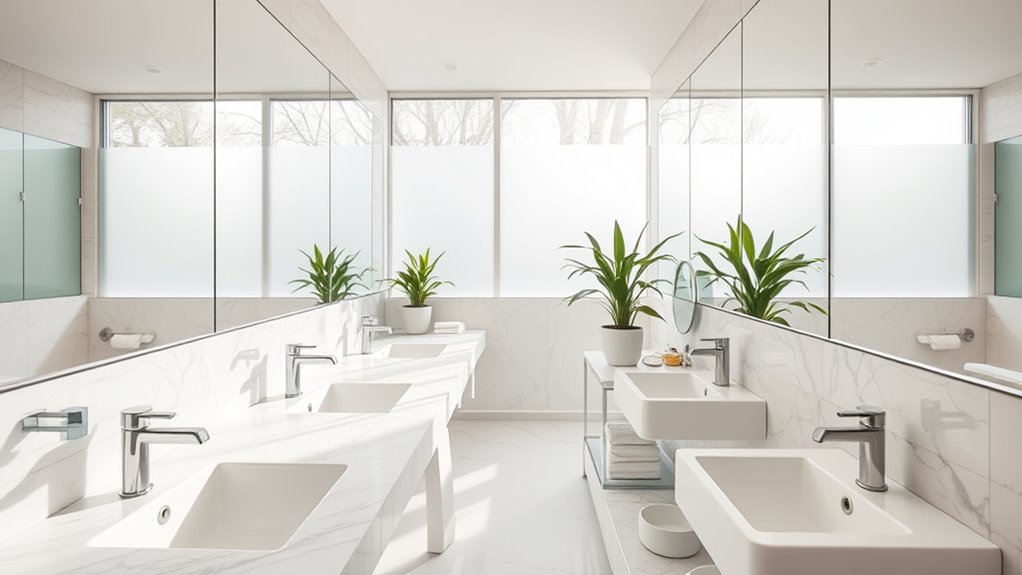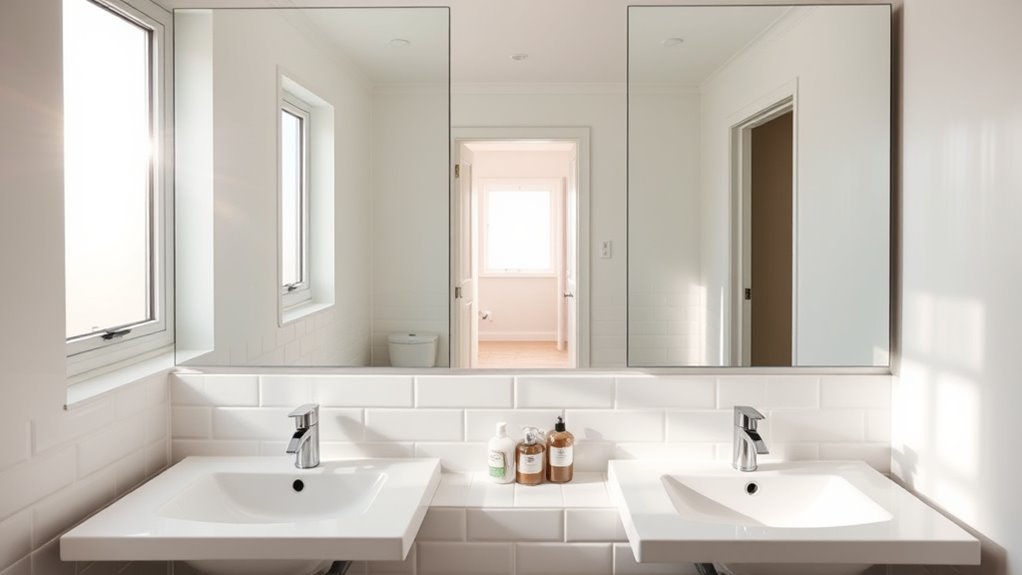To avoid morning traffic jams in shared bathrooms, plan and stagger everyone’s routines. Communicate openly about your schedules, respect others’ times, and keep the space organized. Use strategies like installing additional fixtures or timers to manage usage. Cooperating and sticking to routines helps mornings run smoothly and reduces stress. If you want practical tips on creating an efficient, jam-free bathroom space, keep exploring ways to coordinate and improve your shared bathroom routines.
Key Takeaways
- Implement a staggered schedule for bathroom routines to prevent peak congestion.
- Communicate and coordinate schedules with all users to ensure timely usage.
- Keep the bathroom organized and clutter-free for quick access and reduced delays.
- Consider installing additional fixtures or a second sink to distribute usage evenly.
- Use timers or set routines to limit individual bathroom time and promote efficiency.

Have you ever wondered what it’s like to share a bathroom with others? It can be a challenge, especially during busy mornings when everyone rushes to get out the door. The crowded rush often leads to long waits, frustration, and a scramble for the mirror. But it doesn’t have to be that way. With a few smart strategies, you can enjoy shared bathrooms without the chaos of morning traffic jams.
Sharing a bathroom can be challenging, but with smart planning, mornings can run smoothly.
The key is to plan ahead and establish routines that spread out usage times. If you’re sharing a bathroom with family or roommates, coordinate your schedules so that peak times are staggered. For example, one person can shower early, while another waits until later. Communicate openly about your needs, and respect each other’s routines. If everyone sticks to a rough timetable, you’ll find the bathroom remains accessible without bottlenecks.
Another effective tip is to make use of off-peak hours. Early mornings or late evenings tend to be less crowded, giving you a better chance to get ready without the pressure of others waiting behind you. If your schedule allows, shifting certain routines—like brushing teeth or quick showers—can make a noticeable difference. This way, you avoid the rush and create space for everyone to start their day smoothly.
Organizing the bathroom space itself also helps. Keep essentials like soap, toothpaste, and hair tools well-stocked and organized so you don’t waste time searching for items. Installing additional storage or hooks can prevent clutter, making it easier to share the space efficiently. When everyone knows where things belong, it reduces delays and keeps the bathroom accessible.
You can also introduce simple rules that promote courtesy and efficiency. For instance, agree on a maximum time limit for showers or brushing routines. Encourage everyone to be punctual and mindful of others waiting. Small acts of patience and consideration go a long way in preventing conflicts and keeping the bathroom flowing smoothly.
Finally, consider investing in some upgrades if possible. Installing a second sink or adding a bathroom timer can help distribute usage more evenly. Even small modifications can make a significant difference in reducing congestion during busy mornings. When shared spaces are well-organized and everyone follows a plan, mornings become less stressful and more manageable.
In essence, avoiding morning traffic jams in shared bathrooms requires a bit of planning and cooperation. By communicating openly, staggering routines, and making smart adjustments, you can transform a usually chaotic space into one that functions efficiently for everyone. This not only saves time but also creates a more pleasant start to each day, free from the frustration of crowded, hurried mornings. Additionally, investing in high-quality home fixtures like durable faucets and efficient lighting can improve the overall functionality and comfort of your shared bathroom space.
Frequently Asked Questions
How Can I Prevent Disputes Over Bathroom Usage Times?
To prevent disputes over bathroom usage times, set clear schedules and communicate them openly with everyone involved. Create a shared timetable, so each person knows their designated slots, and stick to it consistently. Use a timer or alarm to remind you of your time. Respect others’ slots, and be flexible if someone needs extra time occasionally. Clear communication and mutual respect help keep bathroom disputes from escalating.
What Are the Best Cleaning Schedules to Maintain Hygiene?
You should establish a clear cleaning schedule that assigns specific tasks and times for each person. For example, everyone can take turns cleaning the bathroom every few days or after use. Keep supplies like disinfectant, paper towels, and brushes accessible. Regularly disinfect high-touch surfaces, such as faucets and handles, and encourage everyone to wipe down surfaces after use. Consistency guarantees hygiene and reduces conflicts over cleanliness.
How Can Noise Be Minimized in Shared Bathroom Spaces?
Imagine your bathroom as a peaceful oasis, not a noisy chaos. To minimize noise, install soft-close toilets and drawers, which gently close with a whisper. Use rugs and fabric curtains to absorb sound. Encourage everyone to keep voices low and avoid slamming doors or running water unnecessarily. By creating a calm environment, you make certain everyone enjoys a tranquil, noise-free shared bathroom experience.
Are There Specific Design Features That Reduce Congestion?
Yes, you can reduce congestion by designing bathrooms with separate stalls and multiple sinks to spread out users. Incorporate clear signage to direct flow and create designated pathways. Installing multiple entry points or adding partitions helps manage movement smoothly. Using mirrors strategically can also prevent bottlenecks. These features encourage efficient use, minimize wait times, and help maintain a steady, organized flow during busy hours.
What Safety Measures Should Be Implemented in Shared Bathrooms?
You should install slip-resistant flooring and ensure proper lighting to prevent accidents. Adding clear signage and installing automatic locks can enhance safety by reducing confusion and unauthorized access. Regular maintenance, like checking for leaks or damages, is essential. These measures create a secure environment, encouraging users to feel comfortable and confident. Don’t overlook the importance of ventilation—good airflow helps prevent mold and unpleasant odors, keeping the space safe and inviting.
Conclusion
Now, imagine a future where shared bathrooms are as common as the town square’s fountain, free of morning traffic jams. You step in, knowing everyone respects the flow, making mornings smoother than a Victorian tea party. With thoughtful design and community trust, you can turn chaos into calm—no need for a time machine, just a little modern ingenuity. Embrace these spaces, and dawn will greet you with less rush and more peace.









